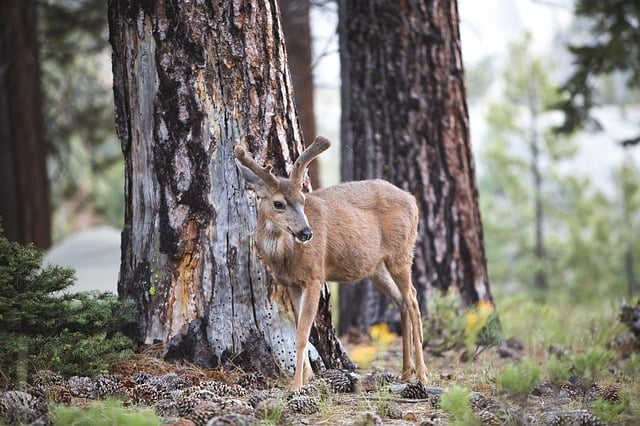How to Safely Observe Animals in their Natural Habitat
Naturalist and National Wildlife Federation representative David Mizejewski shares his expert tips for safely observing wildlife in their natural habitat.

One of the most exciting parts of camping is the chance to experience the wonderful diversity of wildlife that populate our forests, grasslands, mountains, and deserts.
But any parent who has promised their kids an alligator sighting in central Florida knows it’s not always easy to spot wild animals! (And sometimes in hindsight you might be glad you failed.)
Finding Animals in Their Natural Habitat
Here are some tips for maximizing your chances of having an incredible wildlife experience while you’re camping or exploring.
Go to Where the Animals Are
No matter where you choose to camp or explore, you’ll find wildlife of all shapes and sizes. But if you want to make sure you have the best opportunity to see wild animals, do your research before you decide where to go.
If you want to see large species, choose a National Park or wilderness area that’s also home to bears, wolves, large flocks of birds, alligators, elk, bison, schools of fish, bald eagles, pronghorn, bighorn sheep or moose.
Also, plan to go at the time of year that these animals are present and most easy to spot. Many species are migratory or gather together at certain times of the year, so choose those times to camp.
Broaden Your View of Wildlife
When most of us think of wildlife, likely images of large mammals or birds come to mind, but the fauna of North America come in all shapes and sizes.
For example, the world of invertebrates is incredibly diverse and equally as fascinating. Yes, bugs are wildlife! So are reptiles, amphibians, and fish.
Broaden your view of wildlife, and you’ll be rewarded. Explore your campsite to see how many insects, spiders, crayfish, pill bugs, worms and other invertebrates you can spot. It’ll give you a whole new appreciation for the natural world.
Use All of Your Senses
Experiencing wildlife in their natural habitat while camping doesn’t always mean you’ll see it with your eyes. Use all of your senses. Veteran birders will tell you that you more often hear a bird than see it. The same goes for frogs and toads, which are experts at camouflage but quite vocal during the breeding season.
Learning the calls of wildlife is like understanding a new language. What sounded like background noise before will become a cacophony of communication that you suddenly understand. Many wildlife species communicate with scent, so use your nose too. You might be surprised at what wildlife you can detect that you never even see.
Learn Tracks and Signs
Again, remember that you needn’t always have a visual encounter with an animal to have a wildlife experience. Wildlife leave all sorts of signs that will alert you to their presence if you know what to look for.
Spend some time learning the tracks of the wildlife that live where you’re camping. Seek out muddy areas that are most likely to hold tracks and try to identify the species that have passed through. Educate yourself on other signs of various species, such as territorial markings, gnaw marks, burrows, nests, bones and even scat. All are clues about wildlife around you.
Be Still
Wild animals are generally wary of human beings and will avoid us at all costs. To experience them, you’ll need to follow their lead and learn how to be still and silent.
That can be hard for us modern humans who live in cities and towns with constant motion and things to keep our attention. But how wonderful is the idea of finding a secluded spot in nature to quietly sit and take it all in?
Use Technology If You Want
Having a wildlife experience doesn’t mean you have to eschew modern technology. Invest in a good pair of binoculars and a camera with a zoom lens. Today, even most smartphones can take quality images at close range to enjoy later or use to identify species you see.
Camouflage clothing can give you an edge in staying hidden and increasing your chances of seeing wildlife. There are many great apps that you can download to help with identifying bird calls, frog calls, tracks and even plants. Use technology to enhance your wildlife encounters while camping.
Want to find more opportunities to observe wildlife in their natural habitat? Take the National Wildlife Federation’s Great American Campout pledge and find great camping resources and information at the Great American Campout page.
Young campers can get in on the camping fun with great ideas from the National Wildlife Federation’s wildlife ambassador Ranger Rick.
For more outdoor activities with kids, try this nature scavenger hunt or these camping games.
